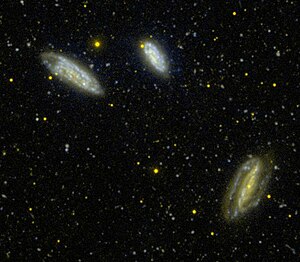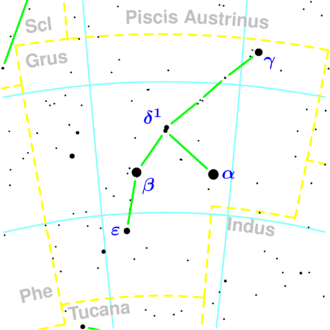NGC 7599
| Galaxy NGC 7599 |
|
|---|---|

|
|
| NGC 7582 (right), NGC 7590 and NGC 7599 (left) | |
| AladinLite | |
| Constellation | crane |
|
Position equinox : J2000.0 , epoch : J2000.0 |
|
| Right ascension | 23 h 19 m 21.1 s |
| declination | -42 ° 15 ′ 25 ″ |
| Appearance | |
| Morphological type | SB (s) c / LINER |
| Brightness (visual) | 11.5 likes |
| Brightness (B-band) | 12.2 mag |
| Angular expansion | 4.40 × 1.4 |
| Position angle | 57 ° |
| Surface brightness | 13.3 mag / arcmin² |
| Physical data | |
| Affiliation | Grus Quartet SSRS Group 40 NGC 7582 Group LGG 472 |
| Redshift | 0.005508 ± 0.000017 |
| Radial velocity | 1651 ± 5 km / s |
|
Stroke distance v rad / H 0 |
(73 ± 5) · 10 6 ly (22.3 ± 1.6) Mpc |
| history | |
| discovery | John Herschel Lewis Swift (IC 5308) |
| Discovery date | September 2, 1836 1897 |
| Catalog names | |
| NGC 7599 • IC 5308 • PGC 71066 • ESO 347-034 • MCG -07-47-033 • IRAS 23166-4231 • 2MASX J23192114-4215246 • SGC 231636-4231.8 • LDCE 1559 NED009 | |
NGC 7599 = IC 5308 is a bar-spiral galaxy with an active nucleus of the Hubble type SBc in the constellation Crane in the southern sky . It is an estimated 73 million light years from the Milky Way and about 95,000 light years in diameter.
Together with NGC 7552 , NGC 7582 and NGC 7590 , it forms the Grus Quartet.
The object was discovered by John Herschel on September 2, 1836 .
Web links
Commons : NGC 7599 - collection of images, videos, and audio files
